By Oliver B. Pollak
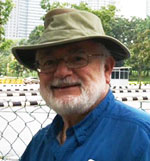
HANNOVER, Germany and TEREZIN, Czech Republic — Our roots trip has dispersed with cousins going separate ways to Berlin, Munich, and Rome. My party of five headed to Hannover and Theresienstadt, a path my grandfather took in 1942 and in reverse in 1945.
Grandfather, Dr. Felix Bachmann, with his new English wife arrived in Hannover to practice obstetrics and gynecology. He went into the German army medical corps in 1914, and incurred a shrapnel wound to his right arm effectively ending his surgical career. Germany was generous to its warriors. He became a disability examiner.
Hitler’s rise rested in great part on further rewarding German veterans. Opa received the Ehrenkreuz fur Frontkampfer, the Honor Cross for Front Warriors, in 1933. But as a Jew his professional, social and economic life started to narrow. The other side of Nazi policy restricted the employment opportunities and introduced unrelenting race hatred. Many Jews saw the writing on the wall and left their beloved Germany in 1933. For Felix love of country and cosmopolitan life outweighed intelligence; he stayed believing that Hitler was a temporary phenomenon.
The Yad Vashem Holocaust Memorial in Jerusalem provided two Hannover addresses for Opa Bachmann. First was the last known address before being deported to “T”, grandpa’s shorthand in his account of Terezin. The second, his address after being released from Deggendorff Displaced Persons camp in September.
The first address, 16 Ellernstrsaße, is in the Kleefeld neighborhood. School for his daughters Reni and Ruth who were born in 1915 and 1921 was around the corner at Sophienschule which opened in 1900. The school’s modern motto is “Schule ohne Rassismus — Schule mit Courage;” ‘School without racism, School with courage.’
We hydrated in the mid 80s heat at Göings, a corner café and backerei. Sitting outside we saw bicyclists, children getting out of school, mothers pushing their strollers, street workmen and “Sauber (clean?) Hannover” signs on municipal vans. All the German cities, towns, villages, hamlet were schmutz rein.
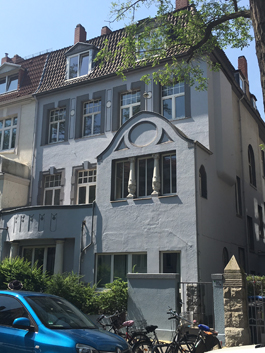
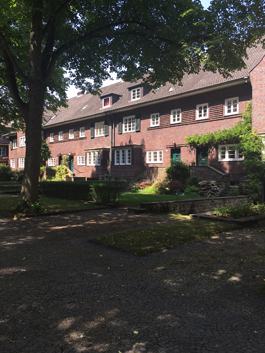
The second address from Yad Vashem was 7 Wallmodenstraße, also in the tree lined Kleefeld. According to a man in his twenties opening this green door no. 7, after the war high ranking American officers also occupied the building. Opa lived here until 1947, visited us in London and decamped for Ohio were he got a job as a doctor in a tuberculosis sanitarium.
About 6,800 Hannoverians were deported by the Nazis. The enormity of the involuntary exodus is captured by two memorials. We parked the car and almost immediately beneath our feet were fourteen Stolpersteine for Albert, Anna, Antonia, Dina, Frieda, Gisela, Henny, Henry, Johanna, Mala, Nissert, Paul, Rose, Wanda, and Werner Fischer, in front of an Asian restaurant. They all went to Auschwitz, may their names be a blessing,
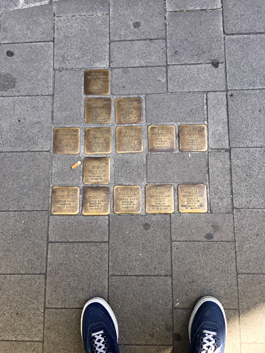
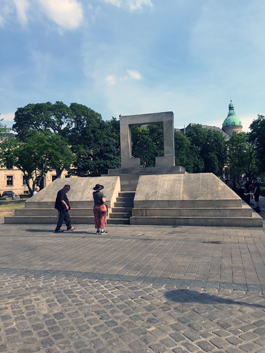
At the Mall we ate at Café Extrablatt. Google and the German Australian waitress indicated that the Holocaust Memorial was a four-minute walk away. It took us direction-challenged and a little older than the Google map’s walking demographic a few more than four minutes.
The Holocaust Mahnmal (a monument that is a reminder of a tragic event), dedicated in 1994 is engraved with 1,900 names, destinations — Riga, Theresienstadt, Auschwitz — and dates of death, is prominently located in an open space between the Opera House and the shopping mall. The young people rolling cigarettes, displaying shocks of green hair, drinking vodka, and laughing were out of context but not consciously disrespectful – ‘let’s hangout in the park smoke and drink, the monument has built in seats.’
We visited the stupendous Neues Rathaus (New Town Hall) completed in 1913. It had four 12×12 foot models of the city. The 1939 model clearly and openly indicates the destruction of the main synagogue in 1938, and no doubt anticipated tourist questions. The 1945 display showed the effect of massive allied bombing.
Driving on the autobahn from Hannover to Prague we passed by Terezin 4 ½ hours into the trip. Opa’s trip to T by truck and train was no doubt more arduous and uncertain. He arrived in July 1942 and left in May 1945. He was unjustifiably imprisoned about 1,100 days.
We took a one-hour tour bus ride to Terezin. There were twenty on the bus. None other than us had family connections to Terezin. As far as I could tell they were interested Gentiles with lots of questions. Terezin was not an extermination camp but a halfway house on the way to Auschwitz or death accelerated by neglect, aging, malnutrition, infection, and pneumonia. My sister and I were in T for an uncomfortable three hours.

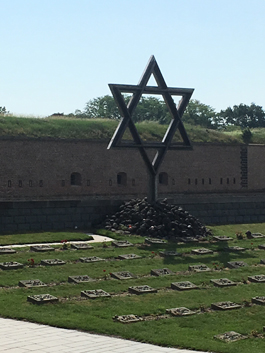
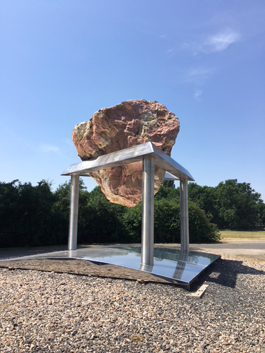
Enormous wrongs led to monumental symbols of loss and contrition. The enormous Star of David and Menorah overlook two cemeteries. The boulder suspended as in a ring setting was dedicated in January 2015 by Moshe Kantor, President of the European Jewish Congress on the occasion of the 70th anniversary of the Liberation of Theresienstadt (which was the German name for Terezin). With no graves for visitors to place individual stones upon, this is a monument to the unknown resting places of the incinerated including our Viennese paternal grandmother and my maternal German great aunt and uncle.
Opa died in 1956 in Palm Springs at the age of 75. His three grandchildren were 20, 13, and 6. Ralph and I treasure the letters he wrote in 1945 asking about his grandchildren. My brother Ralph said “he was my favorite person. We laughed together. He was my introduction to the Bachmann belly.” He also recalled seeing Fantasia sitting between his estranged grandparents. I had my Bar Mitzvah shortly after his death, and I mentioned Opa in my drash. Judy, the youngest, has no lasting impressions.
Opa’s gravestone at Mt. Sinai in Burbank is marked with his name, birth and death, nothing more. He died before “Never forget” became part of Holocaust education. Terezin is a living reminder.
*
Pollak, a professor emeritus of history at the University of Nebraska at Omaha, is a freelance writer now based in Richmond, California. He may be contacted via oliver.pollak@sdjewishworld.com